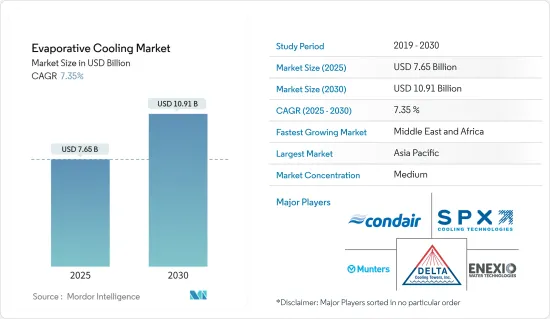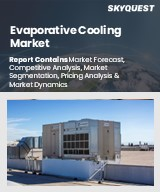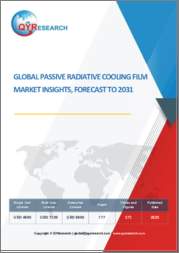
|
시장보고서
상품코드
1686272
증발식 냉각 : 시장 점유율 분석, 산업 동향 및 통계, 성장 예측(2025-2030년)Evaporative Cooling - Market Share Analysis, Industry Trends & Statistics, Growth Forecasts (2025 - 2030) |
||||||
증발식 냉각 시장 규모는 2025년에 76억 5,000만 달러로 추정되고, 2030년에는 109억 1,000만 달러에 이를 것으로 예측되며, 예측 기간(2025-2030년) CAGR은 7.35%를 나타낼 전망입니다.

주요 하이라이트
- 기후 변화로 인해 폭염이 더 자주 발생하면서 수백만 명의 사람들이 치명적일 수 있는 온도에 노출될 위험에 처해 있습니다. 전 세계 사람들이 기온 상승의 영향을 받고 있는 상황에서 탄소 배출량을 줄이면서 냉방에 대한 필요성을 해결하는 것이 필수적인데, 이는 업계를 이끄는 중요한 요소로 작용하고 있습니다.
- 증발식 냉각기는 팬, 펌프, 물 등 에어컨 시스템보다 적은 수의 부품을 사용하여 실내를 냉각하기 때문에 적은 비용과 최소한의 운영 비용으로 다양한 공간을 냉방할 수 있습니다. 이러한 증발식 냉방 시스템의 낮은 소유 비용은 주요 장점 중 하나입니다.
- 또한 전 세계 여러 정부에서 에너지 효율이 높은 기술을 장려하기 위해 절약 프로그램을 제공하고 있습니다. 예를 들어, 증발식 냉각은 지속 가능한 냉각 기술로 입증되었기 때문에 네덜란드에서는 이러한 시스템을 에너지 투자 공제(EIA) 대상에 포함시켜 전체 투자에 대해 11% 이상의 순이익을 얻을 수 있도록 했습니다.
- 또한, 증발식 냉각 시스템은 부품 사용량이 적고 에너지 효율이 높기 때문에 시장에서 가장 경제적인 냉각 옵션 중 하나입니다. 예를 들어 Canstar Blue는 일반적인 역순환 분할 시스템 에어컨의 경우 시간당 약 0.60달러로 작동할 수 있다고 추정합니다. 그러나 증발식 냉각 시스템은 물값이 0.02달러가 추가되면 시간당 0.10달러 미만이 될 수 있습니다.
- 이러한 증발식 냉각 시스템은 주변 공기질에 대한 높은 의존도가 주요 단점 중 하나였습니다. 증발식 냉각 공정은 주변 공기의 건구 온도와 습구 온도 사이의 온도 차이에 의해 구동되기 때문에 중간 정도 습도가 높은 지역에서는 이 차이가 무시할 수 있는 수준이기 때문에 냉각 용량이 제한됩니다.
- 한편, 전 세계 규제 당국 중 인도 난방, 냉방 및 공조 엔지니어 협회(ISHRAE)는 현재 팬데믹 상황에서 더 많은 신선한 공기 흡입과 환기를 촉구했습니다. 이로 인해 최종 사용자는 실내 공기질을 크게 개선하고 에너지 사용량을 줄이면서 안전한 작업 공간을 제공할 수 있는 증발식 냉각 시스템의 통합을 고려해야 하는 상황에 처했습니다.
증발식 냉각 시장 동향
직접 증발식 냉각이 큰 점유율을 차지
- 직접 증발식 냉각은 액체 상태의 물을 수증기로 변환하는 증발 잠열을 활용하여 온도를 낮추고 공기 습도를 높입니다. 가장 기본적이고 전통적이며 널리 사용되는 증발식 냉각 방식입니다. 이러한 증발식 냉각제는 7월 한낮의 상대 습도가 40% 이상인 미국 남부 지역을 중심으로 틈새 시장이 제한적으로 형성될 것으로 예상됩니다.
- 직접 증발식 냉각 시스템은 상당한 열 부하 교체가 필요하고 이를 위해 외부 공기를 사용할 의향이 있는 용도에도 적합합니다. 이 시스템은 건물, 창고, 상업용 주방 및 쾌적성 기준이 느슨한 주거 환경에서 널리 사용됩니다. 따라서 시스템 요구 사항은 최종 사용자와 설정된 운영 성능 기준에 따라 달라집니다. 대부분의 건물 증발식 냉각기는 자연식 시스템이지만 일부 간접식 시스템도 사용됩니다.
- 산업 부문은 직접 증발식 쿨러의 대규모 배치로 인해 모든 최종 사용자 용도 중에서 가장 큰 시장 점유율을 차지하고 있습니다. 직접 증발식 냉각기의 산업 응용 분야에는 건물, 창고, 공장, 제조 장치, 발전, 석유 및 가스, 건설 등이 포함됩니다.
- 또한 산업 분야에서는 문제가 발생하기 전에 유지보수의 필요성을 예측하기 위해 첨단 증발식 냉각 시스템을 구현합니다. 사물인터넷(IoT) 기술을 사용하는 최신 냉각 기술에는 시스템이 다른 연결된 장치와 통신할 수 있도록 하는 센서, 연결, 소프트웨어 및 기타 구성 요소가 포함되어 있습니다. IoT 솔루션은 장비 상태와 공기질에 대한 정보를 수집하여 예방적 유지보수를 강화합니다.
- 그 결과 많은 기업이 데이터센터를 냉각하는 가장 에너지 효율적인 방법인 직접 증발식 냉각(DEC)에 집중하고 있습니다. 자연 증발식 냉각을 포함한 데이터센터 냉각 부문을 성장시키기 위해, 예를 들어 문터스는 버지니아 주 직원을 2021년 4월에 새로운 시설로 옮겼습니다. 제조, 연구개발, 판매를 위한 36만 5,000평방피트의 시설은 회사의 3,600만 달러의 투자 목표였습니다.
아시아태평양이 큰 시장 점유율을 차지
- 동남아시아 지역은 기온 상승과 소득 증가로 인해 에어컨 판매 수요가 크게 증가할 것으로 예상되며, 2040년까지 3억 대에 달할 것으로 예상되며 인도네시아가 전 세계 에어컨의 절반을 공급할 것으로 예상됩니다.
- 또한 국제에너지기구의 연구에 따르면 냉방기기 판매는 중국, 미국, 일본이 주도하고 있으며 인도와 인도네시아가 가장 큰 증가세를 보이고 있습니다. 중국은 지난 10년간 5억 대 이상을 판매했지만 인도와 인도네시아의 에어컨 수요가 상대적으로 더 빠르게 증가했으며, 두 국가 모두 연평균 15% 이상의 속도로 설치가 확대되었습니다. (인도)
- 남아시아는 에어컨 수요가 기하급수적으로 증가하면서 경제적이고 간편한 냉방 기술에 대한 필요성이 커지고 있습니다. 이들 국가의 탄소 배출량 감축 목표를 고려할 때 증발식 냉방은 가장 훌륭한 솔루션 중 하나입니다. 동남아시아는 아시아태평양 지역에서 가장 빠르게 성장하는 데이터센터 시장 중 하나이지만, 이 지역에서는 이러한 시설의 지속가능성이 여전히 문제가 되고 있습니다.
- 하지만 향후 몇 년 동안, 특히 Microsoft, Google, Apple과 같은 전 세계 주요 기술 기업들이 탄소 중립 및 제로 지속 가능성 목표를 설정하고 최첨단 에너지 효율 기술이 개발됨에 따라 지속 가능성이 아시아 데이터센터 제공업체 간의 주요 차별화 요소가 될 것으로 예상됩니다.
- 데이터센터의 냉각은 전체 에너지 수요의 35%에서 40%를 차지하기 때문에 아시아의 지속가능성에 큰 장애물이 되고 있습니다. 현재 아시아 지역의 대부분의 데이터 센터는 매우 비효율적이고 비용이 많이 드는 공기 기반 냉각 솔루션을 사용하고 있습니다.
- 이 지역의 기업들은 점점 더 증발식 냉각 기술로 전환하고 있습니다. 예를 들어 증발식 냉각과 같은 냉각 기술 덕분에 데이터 센터의 지속 가능성을 높일 수 있습니다. 데이터 센터가 디지털화의 요구를 수용하기 위해 더욱 중요해짐에 따라 이러한 기술을 통해 기업은 간접 증발식, 직접 증발식, 하이브리드 시스템 및 액체 냉각을 사용하여 전력 사용 효율(PUE)과 전체 에너지 사용량을 줄일 수 있습니다.
증발식 냉각 산업 개요
증발식 냉각 시장은 경쟁이 적당히 치열하며 몇몇 주요 기업으로 구성되어 있습니다. 시장 점유율 측면에서 현재 시장을 지배하는 주요 기업는 거의 없습니다. 시장에서 눈에 띄는 점유율을 가진 이러한 주요 기업는 해외에서 고객 기반을 확장하는 데 주력하고 있습니다. 주요 기업에는 Delta Cooling Towers Inc., Condair Group AG, SPX Cooling Technologies 등의 기업이 포함됩니다. 경쟁과 급속한 기술 진보는 예측 기간 동안 기업의 성장에 위협을 줄 것으로 예상됩니다.
2023년 5월, Xiaomi Youpin은 MIJIA Smart Evaporative Cooling Fan을 출시하여 고객에게 상쾌하고 편안한 실내 환경을 제공했습니다. 이 회사가 출시한 스마트 선풍기는 송풍, 냉방, 가습의 세 가지 효과를 하나로 제공하도록 설계되었습니다. 순환 수냉식 냉각 시스템을 탑재해 물과 얼음 결정을 추가해 다양한 냉각 효과를 낼 수 있습니다. 혁신적인 무선 물탱크 특허 설계로 언제든지 본체에서 탱크를 분리해 청소할 수 있어 위생과 편의성을 보장합니다.
기타 혜택
- 엑셀 형식 시장 예측(ME) 시트
- 3개월간의 애널리스트 지원
목차
제1장 서론
- 조사의 전제조건과 시장 정의
- 조사 범위
제2장 조사 방법
제3장 주요 요약
제4장 시장 인사이트
- 시장 개요
- 산업 밸류체인 분석
- 업계의 매력도 - Porter's Five Forces 분석
- 공급기업의 협상력
- 소비자의 협상력
- 신규 참가기업의 위협
- 경쟁 기업간 경쟁 관계
- 대체품의 위협
- COVID-19의 업계에 대한 영향 평가
- 증발식 냉각 핫스팟 분석
- 주거 및 상업 부문에 배포 된 대체, 대체 냉각 기술의 비교 분석
제5장 시장 역학
- 시장 성장 촉진요인
- 비용 효율적인 냉각 솔루션에 대한 수요
- 시장 성장 억제요인
- 외부 기후에 대한 의존도
제6장 시장 세분화
- 냉각 유형별
- 직접 증발식 냉각
- 간접 증발식 냉각
- 2단계 증발식 냉각
- 용도별
- 주거용
- 상업용
- 산업용
- 컴파인먼트 팜
- 기타 용도
- 유통 채널별
- 대형 소매점
- HVAC기업 및 유통기업
- 기타 유통 채널
- 지역별
- 북미
- 유럽
- 아시아태평양
- 세계 기타 지역
제7장 경쟁 구도
- 기업 프로파일
- Delta Cooling Towers Inc.
- Condair Group AG
- SPX Cooling Technologies
- Baltimore Aircoil Company Inc.
- Munters Group AB
- Colt Group Limited
- Phoenix Manufacturing Inc.
- Bonaire
- ENEXIO Water Technologies GmbH
- CFW Evapcool
- Celsius Design Limited
제8장 투자 분석
제9장 향후의 동향
HBR 25.04.04The Evaporative Cooling Market size is estimated at USD 7.65 billion in 2025, and is expected to reach USD 10.91 billion by 2030, at a CAGR of 7.35% during the forecast period (2025-2030).

Key Highlights
- As heat waves happen more frequently owing to climate change, millions of people are in danger of exposure to temperatures that could be fatal. People worldwide have been impacted by rising temperatures, making it imperative to address the need for cooling without having a negative carbon footprint, which has been a significant element driving the industry.
- Because evaporative coolers employ fewer parts than air conditioning systems, such as a fan, pump, and water, to chill the room, they can cool various spaces for a meager cost and with minimal operational costs. These evaporative cooling systems' low ownership costs are one of their main benefits.
- Additionally, various governments worldwide have been offering saving programs to promote energy-efficient technologies. For example, as evaporative cooling has been a proven sustainable cooling technology, these systems have been made eligible for the Energy Investment Deduction (EIA) in the Netherlands, which could result in more than 11% net benefit on the entire investment.
- Furthermore, because these systems use fewer components and are, therefore, more energy efficient, evaporative cooling has been one of the most affordable cooling options on the market. For instance, Canstar Blue estimates that the typical reverse cycle split system air conditioner may run at about USD 0.60 per hour. However, with an additional USD 0.02 for water, an evaporative cooling system may cost less than USD 0.10 per hour.
- These evaporative cooling systems' high reliance on the surrounding air quality has been one of their main disadvantages. Since the evaporative cooling process is driven by the temperature difference between the ambient air's dry and wet bulb temperatures, this difference is negligible for moderate and highly humid regions, which results in a constrained cooling capacity.
- On the other hand, the Indian Society of Heating, Refrigerating and Air Conditioning Engineers (ISHRAE), among other regulating authorities globally, has urged more fresh air intake and ventilation in the current pandemic scenario. Due to this, end users are now compelled to consider integrating evaporative cooling systems, which might significantly improve indoor air quality and offer secure workspaces with less energy use.
Evaporative Cooling Market Trends
Direct Evaporative Cooling to Hold a Major Share
- By utilizing the latent heat of evaporation, which transforms liquid water into water vapor, direct evaporative cooling reduces the temperature and raises air humidity. It is the most basic, traditional, and widely utilized form of evaporative cooling. These evaporative coolants are anticipated to have a limited niche market in the United States, mainly in the south, where the relative humidity at noon in July is above 40%.
- The direct evaporative cooling systems are also appropriate for applications that require significant heat-load replacement and are willing to use outside air to do it. Their applications are widely used in buildings, warehouses, commercial kitchens, and residential settings with laxer comfort standards. The system requirements, therefore, depend on the end users and the established operational performance criteria. Most buildings' evaporative coolers are natural systems, while some indirect ones are also employed.
- The industrial sector accounts for the largest market share among all end-user applications, driven by the large-scale deployment of direct evaporative coolers. The industrial applications for direct evaporative coolers include Buildings, warehouses, factories, manufacturing units, power generation, oil and gas, construction, and many more.
- Additionally, the industrial sectors implement advanced evaporative cooling systems to foresee the need for maintenance before a problem arises. The most recent cooling technologies, which employ Internet of Things (IoT) techniques, contain sensors, connections, software, and other components that let the system communicate with other connected devices. IoT solutions enhance preventative maintenance by collecting information on equipment status and air quality.
- As a result, many businesses concentrate on direct evaporative cooling (DEC), frequently the most energy-efficient method of cooling a data center. To grow its data center cooling sector, which includes natural evaporative cooling, Munters, for instance, shifted its Virginia staff to the new facility in April 2021. A 365,000-square-foot facility for manufacturing, R&D, and sales was the company's USD 36 million investment target.
The Asia-Pacific Region to Hold Significant Market Share
- The Southeast Asian region is anticipated to experience a significant demand for AC sales, driven by rising temperatures and rising earnings, expected to reach 300 million units by 2040; it is anticipated that Indonesia will supply half of the world's air conditioning units.
- In addition, research from the International Energy Agency states that cooling equipment sales are dominated by China, the United States, and Japan, with India and Indonesia experiencing the most significant rise. Although China sold over 500 million units in the past ten years, India and Indonesia had a relative increase in demand for air conditioning that was more rapid, with average yearly installations expanding at a pace of over 15% in both countries. (India)
- South Asia is experiencing exponential growth in the demand for air conditioning, driving the need for economic and simple cooling techniques. When considering these nations' targets for reducing carbon emissions, evaporative cooling is one of the finest solutions. Southeast Asia boasts among the Asia-Pacific region's fastest-growing data center marketplaces, although the sustainability of these facilities is still a problem for the area.
- Nevertheless, it is anticipated that in the upcoming years, sustainability will become a key differentiator in Asia between data center providers, particularly as leading tech companies around the world, like Microsoft, Google, and Apple, set standards with carbon neutral and zero sustainability goals and as cutting-edge energy-efficient technology is developed.
- Since data center cooling accounts for between 35% and 40% of overall energy demand, it represents a significant hurdle to sustainability in Asia. Most data centers in the area currently employ air-based cooling, a very ineffective and expensive solution.
- Companies in the area are switching more and more to evaporative cooling techniques. For instance, data centers can be sustainable thanks to cooling technology like evaporative cooling. As data centers become more prominent to accommodate the demands of digitalization, these technologies enable businesses to employ indirect evaporative, direct evaporative, hybrid systems, and liquid cooling to reduce Power Usage Effectiveness (PUE) and overall energy usage.
Evaporative Cooling Industry Overview
The Evaporative Cooling Market is moderately competitive and consists of several major players. In terms of market share, few of the major players currently dominate the market. With a prominent share in the market, these major players are focusing on expanding their customer base across foreign countries. The major players include companies like Delta Cooling Towers Inc., Condair Group AG, SPX Cooling Technologies, etc. The competition and rapid technological advancements are expected to pose a threat to the growth of the companies during the forecast period.
In May 2023, Xiaomi Youpin launched the MIJIA Smart Evaporative Cooling Fan, which provides its customers with a refreshing and comfortable indoor environment. The smart fan launched by the company has been designed to provide three effects in one - blowing, cooling, and humidifying. It would be equipped with a circulating water cooling system, which allows the addition of water and ice crystals to bring different cooling effects. The innovative wireless water tank patent design allows the tank to be removed from the body for cleaning at any time, ensuring hygiene and convenience.
Additional Benefits:
- The market estimate (ME) sheet in Excel format
- 3 months of analyst support
TABLE OF CONTENTS
1 INTRODUCTION
- 1.1 Study Assumptions and Market Definition
- 1.2 Scope of the Study
2 RESEARCH METHODOLOGY
3 EXECUTIVE SUMMARY
4 MARKET INSIGHTS
- 4.1 Market Overview
- 4.2 Industry Value Chain Analysis
- 4.3 Industry Attractiveness - Porter's Five Forces Analysis
- 4.3.1 Bargaining Power of Suppliers
- 4.3.2 Bargaining Power of Consumers
- 4.3.3 Threat of New Entrants
- 4.3.4 Intensity of Competitive Rivalry
- 4.3.5 Threat of Substitutes Products
- 4.4 An Assessment of the Impact of COVID-19 on the industry
- 4.5 Analysis of the Evaporative Cooling Hotspot
- 4.6 Comparative Analysis of Alternative/Substitute Cooling Technologies Deployed in the Residential and Commercial Sectors
5 MARKET DYNAMICS
- 5.1 Market Drivers
- 5.1.1 Demand for Cost-effective Cooling Solution
- 5.2 Market Restraints
- 5.2.1 Dependency on External Climate
6 MARKET SEGMENTATION
- 6.1 By Type of Cooling
- 6.1.1 Direct Evaporative Cooling
- 6.1.2 Indirect Evaporative Cooling
- 6.1.3 Two-stage Evaporative Cooling
- 6.2 By Application
- 6.2.1 Residential Applications
- 6.2.2 Commercial Applications
- 6.2.3 Industrial Applications
- 6.2.4 Confinement Farming
- 6.2.5 Other Applications
- 6.3 By Distribution Channel
- 6.3.1 Big-box Retailers
- 6.3.2 HVAC Contractors and Distributors
- 6.3.3 Other Distribution Channels
- 6.4 By Geography
- 6.4.1 North America
- 6.4.2 Europe
- 6.4.3 Asia-Pacific
- 6.4.4 Rest of the World
7 COMPETITIVE LANDSCAPE
- 7.1 Company Profiles
- 7.1.1 Delta Cooling Towers Inc.
- 7.1.2 Condair Group AG
- 7.1.3 SPX Cooling Technologies
- 7.1.4 Baltimore Aircoil Company Inc.
- 7.1.5 Munters Group AB
- 7.1.6 Colt Group Limited
- 7.1.7 Phoenix Manufacturing Inc.
- 7.1.8 Bonaire
- 7.1.9 ENEXIO Water Technologies GmbH
- 7.1.10 CFW Evapcool
- 7.1.11 Celsius Design Limited



















